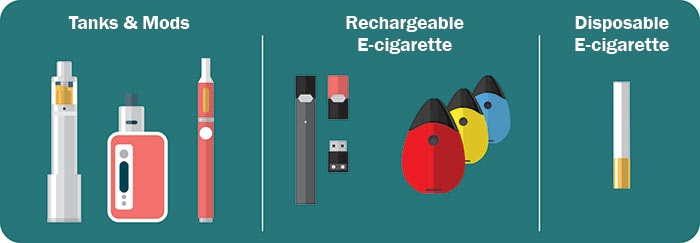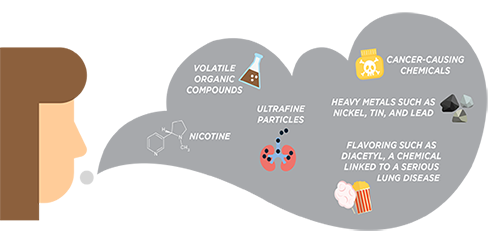About Electronic Cigarettes (E-Cigarettes)
- E-cigarettes have the potential to benefit adults who smoke and who are not pregnant if used as a complete substitute for regular cigarettes and other smoked tobacco products.
- E-cigarettes are not safe for youth, young adults, pregnant adults, as well as adults who do not currently use tobacco products.
- While e-cigarettes have the potential to benefit some people and harm others, scientists still have a lot to learn about whether e-cigarettes are effective in helping adults quit smoking.
- If you’ve never smoked or used other tobacco products or e-cigarettes, don’t start.
- Additional research can help understand long-term health effects.

E-cigarettes are not safe for youth, young adults, and pregnant women, as well as adults who do not currently use tobacco products.
- E-cigarettes come in many shapes and sizes. Most have a battery, a heating element, and a place to hold a liquid.
- E-cigarettes produce an aerosol by heating a liquid that usually contains nicotine—the addictive drug in regular cigarettes, cigars, and other tobacco products—flavorings, and other chemicals that help to make the aerosol. Users inhale this aerosol into their lungs. Bystanders can also breathe in this aerosol when the user exhales into the air.
- E-cigarettes are known by many different names. They are sometimes called “e-cigs,” “e-hookahs,” “mods,” “vape pens,” “vapes,” “tank systems,” and “electronic nicotine delivery systems (ENDS).”
- Some e-cigarettes are made to look like regular cigarettes, cigars, or pipes. Some resemble pens, USB sticks, and other everyday items. Larger devices such as tank systems, or “mods,” do not resemble other tobacco products.
- Using an e-cigarette is sometimes called “vaping.”
- E-cigarettes can be used to deliver marijuana and other drugs.

Some e-cigarettes are made to look like regular cigarettes, cigars, or pipes.
Some resemble pens, USB sticks, and other everyday items.
The e-cigarette aerosol that users breathe from the device and exhale can contain harmful and potentially harmful substances, including:
- Nicotine
- Ultrafine particles that can be inhaled deep into the lungs
- Flavoring such as diacetyl, a chemical linked to a serious lung disease
- Volatile organic compounds
- Cancer-causing chemicals
- Heavy metals such as nickel, tin, and lead1
It is difficult for consumers to know what e-cigarette products contain. For example, some e-cigarettes marketed as containing zero percent nicotine have been found to contain nicotine.2
What is in e-cigarette aerosol?

Most e-cigarettes contain nicotine, which is addictive and toxic to developing fetuses. Nicotine exposure can also harm adolescent and young adult brain development, which continues into the early to mid-20s.1 E-cigarette aerosol can contain chemicals that are harmful to the lungs. And youth e-cigarette use is associated with the use of other tobacco products, including cigarettes.
For more information about the risks of e-cigarettes for young people, visit Quick Facts on the Risks of E-cigarettes for Kids, Teens, and Young Adults.

Yes—but that doesn’t mean e-cigarettes are safe. E-cigarette aerosol generally contains fewer toxic chemicals than the deadly mix of 7,000 chemicals in smoke from regular cigarettes.3 However, e-cigarette aerosol is not harmless. It can contain harmful and potentially harmful substances, including nicotine, heavy metals like lead, volatile organic compounds, and cancer-causing agents.1

E-cigarettes are not currently approved by the FDA as a quit smoking aid. The U.S. Preventive Services Task Force, a group of health experts that makes recommendations about preventive health care, has concluded that evidence is insufficient to recommend e-cigarettes for smoking cessation in adults, including pregnant adults.3

However, e-cigarettes may help non-pregnant adults who smoke if used as a complete substitute for all cigarettes and other smoked tobacco products.
- To date, the few studies on the issue are mixed. A Cochrane Review found evidence from two randomized controlled trials that e-cigarettes with nicotine can help adults who smoke stop smoking in the long term compared with placebo (non-nicotine) e-cigarettes.4 However, there are some limitations to the existing research, including the small number of trials, small sample sizes, and wide margins of error around the estimates.
- A recent CDC study [PDF – 197 KB] found that many adults are using e-cigarettes in an attempt to quit smoking.5 However, most adult e-cigarette users do not stop smoking cigarettes and are instead continuing to use both products (known as “dual use”).7 Dual use is not an effective way to safeguard your health, whether you’re using e-cigarettes, smokeless tobacco, or other tobacco products in addition to regular cigarettes. Because smoking even a few cigarettes a day can be dangerous,6 quitting smoking completely is very important to protect your health.
E-cigarettes are the most commonly used tobacco product among youth.
- In 2023, 2.13 million U.S. middle and high school students used e-cigarettes in the past 30 days, including 4.6% of middle school students and 10.0% of high school students.9
- In 2022, 2.55 million U.S. middle and high school students used e-cigarettes in the past 30 days, including 3.3% of middle school students and 14.1% of high school students.9
- In 2021, 4.5% of U.S. adults currently used e-cigarettes.10
- In 2019, among adults who currently used e-cigarettes overall, 36.9% also currently smoked cigarettes, 39.5% formerly smoked cigarettes, and 23.6% had never smoked cigarettes.11
- Among adults who currently used e-cigarettes, the percentage who have never smoked cigarettes is highest among those aged 18–24 years (56.0%), and is lower in older age groups.11
- US Department of Health and Human Services. E-cigarette use among youth and young adults: a report of the Surgeon General [PDF – 8.5 MB]. Atlanta, GA: US Department of Health and Human Services, CDC; 2016.
- Goniewicz ML, Gupta R, Lee YH, et al. Nicotine levels in electronic cigarette refill solutions: a comparative analysis of products from the U.S., Korea, and Poland. Int J Drug Policy. 2015;26(6):583–588.
- Patnode CP, Henderson JT, Thompson JH, Senger CA, Fortmann SP, Whitlock EP. Behavioral Counseling and Pharmacotherapy Interventions for Tobacco Cessation in Adults, Including Pregnant Women: A Review of Reviews for the U.S. Preventive Services Task Force. Evidence Synthesis No. 134. AHRQ Publication No. 14-05200-EF-1. Rockville, MD: Agency for Healthcare Research and Quality; 2015.
- Hartmann-Boyce J, McRobbie H, Bullen C, Begh R, Stead LF, Hajek P. Can electronic cigarettes help people stop smoking, and are they safe to use for this purpose? Published 13 September 2016.
- Caraballo RS, Shafer PR, Patel D, Davis KC, McAfee TA. Quit Methods Used by US Adult Cigarette Smokers, 2014–2016. Prev Chronic Dis 2017; 14:160600.
- Bjartveit K, Tverdal A. Health Consequences of Smoking 1-4 Cigarettes Per Day. Tobacco Control 2005;14(5):315–20.
- QuickStats: Cigarette Smoking Status Among Current Adult E-cigarette Users, by Age Group — National Health Interview Survey, United States, 2015. MMWR Morb Mortal Wkly Rep 2016;65:1177.
- Park-Lee E, Ren C, Sawdey M, et al. Notes from the Field: E-Cigarette Use Among Middle and High School Students — National Youth Tobacco Survey, United States, 2021. Morbidity and Mortality Weekly Report, 2021; 70:1387–9.
- Birdsey J, Cornelius M, Jamal A, et al. Tobacco Product Use Among U.S. Middle and High School Students — National Youth Tobacco Survey, 2023. MMWR Morb Mortal Wkly Rep 2023; 72(44);1173–1182.
- Cornelius ME, Loretan CG, Jamal A, et al. Tobacco Product Use Among Adults — United States, 2021. MMWR Morb Mortal Wkly Rep 2023;72:475–483.
- Cornelius ME, Wang TW, Jamal A, Loretan C, Neff L. Tobacco Product Use Among Adults – United States, 2019. Morbidity and Mortality Weekly Report, 2020. Volume 69(issue 46); pages 1736–1742. [accessed 2020 November 19].






